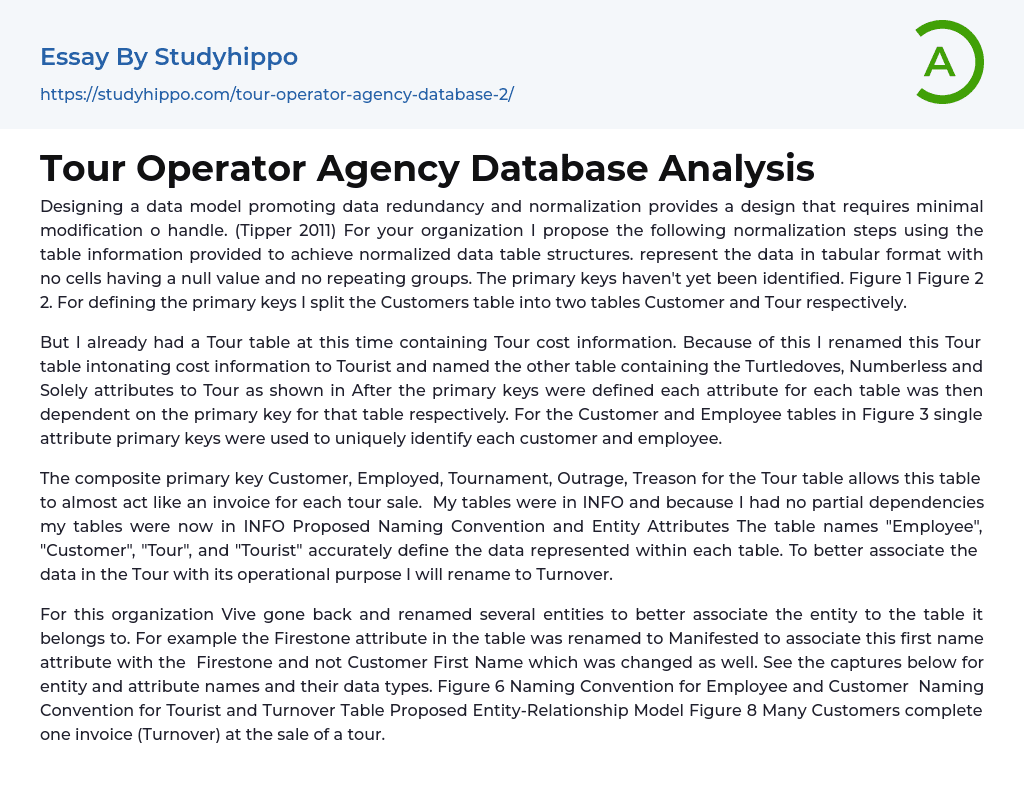To minimize the need for modifications, it is recommended to design a data model that combines data redundancy and normalization (Tipper 2011). In order to achieve normalized data table structures for your organization, follow these steps using the provided table information: represent the data in tabular format while ensuring no cells have null values and there are no repeating groups. At this point, primary keys have not been identified yet. Refer to Figure 1 and Figure 2.
To define the primary keys, a proposal is made to split the Customers table into two separate tables - Customer and Tour.
At that time, I had a Tour table with cost information. To differentiate between the tables, I changed the name of the Tour table to Tourist, emphasizing the cost information. The other table, which included attributes such as Turtledov
...es, Numberless, and Solely, was renamed to Tour. After establishing primary keys for each table, the attributes were dependent on their respective primary keys. In Figure 3, the Customer and Employee tables utilized single attribute primary keys to ensure each customer and employee could be uniquely identified.
The Tour table uses a composite primary key consisting of Customer, Employed, Tournament, Outrage, and Treason. This allows the table to function almost like an invoice for every tour sale. My tables previously resided in the INFO database, but now they are part of the INFO Proposed Naming Convention and Entity Attributes. The table names "Employee," "Customer," "Tour," and "Tourist" accurately describe the data contained in each table. In order to more closely align the data in the Tour table with its operational purpose, I will rename it to Turnover.
align="justify">
Several entities in our organization have been renamed to better match the tables they belong to. For example, we changed the attribute "Firestone" in the table to "Manifested" to associate it correctly with Firestone instead of the Customer's first name attribute, which was also modified. Please see the screenshots below for entity and attribute names, as well as their respective data types. Figure 6 displays the naming convention for Employee and Customer, while Figure 8 demonstrates the naming convention for Tourist and Turnover Table. It's important to note that multiple customers can complete a single invoice (Turnover) during a tour.
- Research Methods essays
- Experiment essays
- Hypothesis essays
- Observation essays
- Qualitative Research essays
- Theory essays
- Explorer essays
- Data Management essays
- Enterprise Resource Planning essays
- Data Modeling essays
- Data Warehouse essays
- Operator essays
- Relation essays
- Sql essays
- Agriculture essays
- Albert einstein essays
- Animals essays
- Archaeology essays
- Bear essays
- Biology essays
- Birds essays
- Butterfly essays
- Cat essays
- Charles Darwin essays
- Chemistry essays
- Dinosaur essays
- Discovery essays
- Dolphin essays
- Elephant essays
- Eli Whitney essays
- Environmental Science essays
- Evolution essays
- Fish essays
- Genetics essays
- Horse essays
- Human Evolution essays
- Isaac Newton essays
- Journal essays
- Linguistics essays
- Lion essays
- Logic essays
- Mars essays
- Methodology essays
- Mineralogy essays
- Monkey essays
- Moon essays
- Mythology essays
- Noam Chomsky essays
- Physics essays
- Plate Tectonics essays


Unfortunately copying the content is not possible
Tell us your email address and we’ll send this sample there.
By continuing, you agree to our Terms and Conditions.


